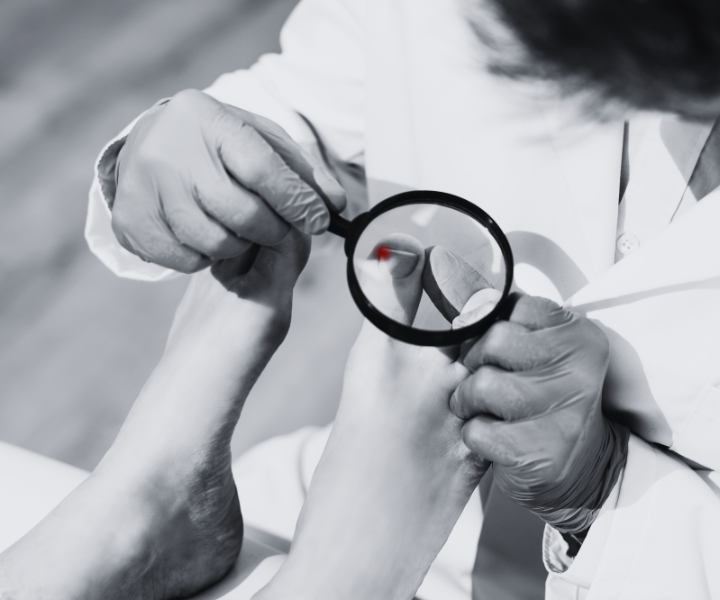What are ingrown toenails
Ingrown toenails, also known as onychocryptosis, occur when the edge or corner of a toenail grows into the surrounding skin, leading to pain, redness, swelling, inflammation and potentially infection. This condition most commonly affects the big toe but can occur in any toenail.
Symptoms of Ingrown Toenails
Ingrown toenails can cause a range of symptoms, including:
- Pain and Tenderness: The affected area becomes painful and tender, especially when pressure is applied or when wearing shoes.
- Redness and Swelling: The skin around the ingrown toenail may appear red, swollen, and inflamed.
- Infection: If left untreated, an ingrown toenail can become infected, resulting in increased pain, pus or drainage, and potential fever.
- Difficulty Wearing Shoes: The discomfort and swelling from an ingrown toenail can make it challenging to wear shoes comfortably.
Causes of Ingrown Toenails
Ingrown toenails can have various causes, including:
- Improper Nail Trimming: Trimming the toenails too short or rounding the edges can cause the nail to grow into the skin. It is important to cut nails straight across and avoid excessively short trimming.
- Tight or Improper Footwear: Wearing shoes that are too tight or narrow can compress the toes, putting pressure on the nails and leading to their improper growth.
- Trauma or Injury: Stubbing the toe or repetitive trauma to the nail area can cause the nail to become ingrown.
- Nail Abnormalities: Some individuals naturally have curved or thick nails, making them more prone to becoming ingrown.
How Can a Podiatrist Diagnose Ingrown Toenails
A podiatrist can diagnose ingrown toenails through a comprehensive consultation and evaluation of the toe(s). This includes:
- Medical History Review: Your podiatrist will discuss your symptoms, medical history, and any factors that may have contributed to the development of ingrown toenails.
- Physical Examination: Your podiatrist will visually inspect the affected toe, assessing the nail and the surrounding skin for signs of redness, swelling, and infection.
- Assessment of Nail Growth: Your podiatrist may evaluate the way your toenails grow, looking for any abnormalities or factors that may contribute to ingrown toenails.
How Can a Podiatrist Treat Ingrown Toenails
Podiatrists offer various treatment options to manage ingrown toenails effectively. The choice of treatment depends on the severity of the ingrown nail and the presence of symptoms. Common treatment approaches include:
Conservative Management: In mild cases, the podiatrist may recommend soaking the affected foot in warm water with Epsom salt, followed by gentle lifting of the ingrown nail edge and placement of a small piece of cotton or dental floss under the nail to encourage it to grow properly.
Antibiotics: If an ingrown toenail becomes infected, you may need to be prescribed antibiotics by your GP to treat the infection. It is important to complete the full course of antibiotics as directed.
Partial Nail Avulsion: In more severe or recurrent cases, the podiatrist may perform a minor surgical procedure called a partial nail avulsion. This involves removing a portion of the ingrown nail and using a chemical or laser treatment to prevent regrowth.
Nail Bracing: For individuals with chronic ingrown toenails, nail bracing techniques can be used to gradually straighten the nail and prevent it from becoming ingrown.
Education and Prevention: Your podiatrist will provide guidance on proper nail care, including how to trim nails straight across, avoid tight footwear, and maintain good foot hygiene.
Ingrown Toenail Treatment and Prevention
In addition to treatment, certain preventive measures can help manage ingrown toenails and reduce the risk of their recurrence:
- Proper Nail Trimming: Trim your toenails straight across, avoiding excessively short trimming and rounding the edges.
- Wear Proper Footwear: Choose shoes that provide ample room for your toes and avoid tight or narrow footwear that puts pressure on the toes and nails.
- Protect the Feet: When engaging in activities that could cause trauma or injury to the feet, such as sports or heavy labour, wear protective footwear to minimise the risk of developing ingrown toenails.
- Maintain Good Foot Hygiene: Keep your feet clean and dry, and inspect them regularly for any signs of ingrown toenails or other foot conditions. Promptly address any foot discomfort or abnormalities to prevent complications. Ensure you maintain regular appointments with your Podiatrist so they can manage and prevent your ingrown toenails. This is especially crucial if you find it hard to maintain foot care yourself, suffer from diabetes, or cannot reach your feet easily.
Summary
Ingrown toenails are an incredibly common condition that our team of podiatrists treat on a regular basis. Prevention and treatment is crucial to staying on top of ingrown toenails and making sure you are not experiencing any pain and discomfort that can be prevented. If you have symptoms of an ingrown toenail or know that you suffer with ingrown toenails on a regular basis and want to discuss the best ingrown toenail treatment options for you, please book in to see our team.
Book an appointment with our friendly team of Podiatrists for Ingrown Toenail Treatment in Melbourne, by calling 03 9878 4566 or emailing [email protected] and we can book you in for a comprehensive consultation and treatment in the closest clinic location that suits you; Blackburn, Melbourne CBD, Newport, Caroline Springs or Springvale.

